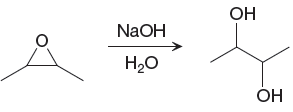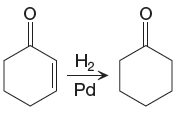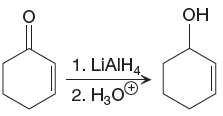
Concept explainers
(a)
Interpretation:
The differences in the IR spectra of the reactant and product that would enable you to tell that the given reaction has taken place are to be determined.
Concept introduction:
The frequencies of the stretching vibrations are estimated from the type of bond and the frequency range given for that bond. Also, the frequency range for the given type of bond is identified by the
Answer to Problem 15.41P
An OH stretch with stretching frequency
Explanation of Solution
The given reaction is

In the above reaction, the OH group, that is the alcohol functional group, is present in the reactant, and C=C bond of
The differences in the IR spectra that would enable to tell that the given reaction has taken place are determined on the basis of bonds and the functional groups present in the reactant and the product.
(b)
Interpretation:
The differences in the IR spectra of the reactant and product that would enable you to tell that the given reaction has taken place are to be determined.
Concept introduction:
The frequencies of the stretching vibrations are estimated from the type of bond and the frequency range given for that bond. Also, frequency range for the given type of bond is identified by the functional group to which that bond resembles in the molecule.
Answer to Problem 15.41P
A very broad OH stretch having stretching frequency
Explanation of Solution
The given reaction is

The
The differences in the IR spectra that would enable to tell that the given reaction has taken place are determined on the basis of bonds and the functional groups present in the reactant and the product.
(c)
Interpretation:
The differences in the IR spectra of the reactant and product that would enable you to tell that the given reaction has taken place are to be determined.
Concept introduction:
The frequencies of the stretching vibrations are estimated from the type of bond and the frequency range given for that bond. Also, frequency range for the given type of bond is identified by the functional group to which that bond resembles in the molecule.
Answer to Problem 15.41P
Two
Explanation of Solution
The given reaction is,

Two
The differences in the IR spectra that would enable to tell that the given reaction has taken place are determined on the basis of bonds and the functional groups present in the reactant and the product.
(d)
Interpretation:
The differences in the IR spectra of the reactant and product that would enable you to tell that the given reaction has taken place are to be determined.
Concept introduction:
The frequencies of the stretching vibrations are estimated from the type of bond and the frequency range given for that bond. Also, frequency range for the given type of bond is identified by the functional group to which that bond resembles in the molecule.
Answer to Problem 15.41P
The single N-H band having stretching frequency
Explanation of Solution
The given reaction is

The single N-H band having stretching frequency
The differences in the IR spectra that would enable to tell that the given reaction has taken place are determined on the basis of bonds and the functional groups present in the reactant and the product.
(e)
Interpretation:
The differences in the IR spectra of the reactant and product that would enable you to tell that the given reaction has taken place are to be determined.
Concept introduction:
The frequencies of the stretching vibrations are estimated from the type of bond and the frequency range given for that bond. Also, frequency range for the given type of bond is identified by the functional group to which that bond resembles in the molecule.
Answer to Problem 15.41P
The
Explanation of Solution
The given reaction is

The epoxide having ether functional group would disappear from the reactant, and an OH band having stretching frequency
The differences in the IR spectra that would enable to tell that the given reaction has taken place are determined on the basis of bonds and the functional groups present in the reactant and the product.
(f)
Interpretation:
The differences in the IR spectra of the reactant and product that would enable you to tell that the given reaction has taken place are to be determined.
Concept introduction:
The frequencies of the stretching vibrations are estimated from the type of bond and the frequency range given for that bond. Also, frequency range for the given type of bond is identified by the functional group to which that bond resembles in the molecule.
Answer to Problem 15.41P
The
Explanation of Solution
The given reaction is

In the above reaction, the
The differences in the IR spectra that would enable to tell that the given reaction has taken place are determined on the basis of bonds and the functional groups present in the reactant and the product.
(g)
Interpretation:
The differences in the IR spectra of the reactant and product that would enable you to tell that the given reaction has taken place are to be determined.
Concept introduction:
The frequencies of the stretching vibrations are estimated from the type of bond and the frequency range given for that bond. Also, frequency range for the given type of bond is identified by the functional group to which that bond resembles in the molecule.
Answer to Problem 15.41P
The
Explanation of Solution
The given reaction is

The
The differences in the IR spectra that would enable to tell that the given reaction has taken place are determined on the basis of bonds and the functional groups present in the reactant and the product.
(h)
Interpretation:
The differences in the IR spectra of the reactant and product that would enable you to tell that the given reaction has taken place are to be determined.
Concept introduction:
The frequencies of the stretching vibrations are estimated from the type of bond and the frequency range given for that bond. Also, frequency range for the given type of bond is identified by the functional group to which that bond resembles in the molecule.
Answer to Problem 15.41P
The strong
Explanation of Solution
The given reaction is

The strong
The differences in the IR spectra that would enable to tell that the given reaction has taken place are determined on the basis of bonds and the functional groups present in the reactant and the product.
(i)
Interpretation:
The differences in the IR spectra of the reactant and product that would enable you to tell that the given reaction has taken place are to be determined.
Concept introduction:
The frequencies of the stretching vibrations are estimated from the type of bond and the frequency range given for that bond. Also, frequency range for the given type of bond is identified by the functional group to which that bond resembles in the molecule.
Answer to Problem 15.41P
The
Explanation of Solution
The given reaction is

The reactant is conjugated ketone in the above reaction. The alcohol and alkene functional groups are present in the product. The
The differences in the IR spectra that would enable to tell that the given reaction has taken place are determined on the basis of bonds and the functional groups present in the reactant and the product.
Want to see more full solutions like this?
Chapter 15 Solutions
Organic Chemistry: Principles And Mechanisms (second Edition)
- + Draw a vicinal alkyl bromide that would produce the following alkene in an E2 elimination. Use a dash or wedge bond to indicate stereochemistry on asymmetric centers, where applicable. Ignore any inorganic byproducts. Br Drawing Strong Base H Q Atoms, Bonds Charges and Rings Draw or tap a new bond to see suggestions. Remove Done 語 Reset Undo + Drag To Panarrow_forwardDraw a vicinal alkyl bromide that would produce the following alkene in an E2 elimination. Use a dash or wedge bond to indicate stereochemistry on asymmetric centers, where applicable. Ignore any inorganic byproducts. + Drawing Į Strong Base H Br Q Atoms, Bonds and Rings Charges Draw or tap a new bond to see suggestions. Undo Reset 謂 Remove Done Drag To Pan +arrow_forwardDraw the product of the E2 reaction shown below. Include the correct stereochemistry. Ignore any inorganic byproducts. + Br CH3 Q Strong Base Drawing Atoms, Bonds and Rings Charges Undo Reset H "Br H N Br. Remove Done .N. Drag To Panarrow_forward
- Curved arrows are used to illustrate the flow of electrons. Use the reaction conditions provided and follow the curved arrows to draw the product of this elementary step in an elimination mechanism. Include all lone pairs and charges as appropriate. Ignore stereochemistry. Ignore byproducts. + Br: .. 8 0.01 M NaOH heat Drawing Q Atoms, Bonds and Rings Charges and Lone Pairs Draw or tap a new bond to see suggestions. Undo Reset Remove Done + Drag To Panarrow_forward+ Draw the product of the E2 reaction shown below. Include the correct stereochemistry. Ignore any inorganic byproducts. Ph CH2CH3 H H3C H Br DBN [૪] Drawing Atoms, Bonds and Rings H | OH Charges ―00 H. C | Undo Reset Br I Remove Done Drag To Pan +arrow_forwardReaction A Now the production A Œ In the product of reaction i 12 Dear the product of actionarrow_forward
- Macmillan Learnin When an unknown amine reacts with an unknown acid chloride, an amide with a molecular mass of 163 g/mol (M* = 163 m/z) is formed. In the infrared spectrum, important absorptions appear at 1661, 750 and 690 cm-1. The 13C NMR and DEPT spectra are provided. Draw the structure of the product as the resonance contributor lacking any formal charges. 13C NMR DEPT 90 200 160 120 80 40 0 200 160 120 80 DEPT 135 200 160 120 80 40 0 Draw the unknown amide. 40 40 0arrow_forwardDraw the major product karmed when I reach with the epoxide. Use walge dah bonds, including hydrogen al alcach genic center, to show the chemistry of the product Beeldraw any hydrogen akams on coxygen where applicablearrow_forwardCurved arrows are used to illustrate the flow of electrons. Using the provided starting and product structures, draw the curved electron-pushing arrows for the following reaction or mechanistic step(s). Be sure to account for all bond-breaking and bond-making steps. H I Select to Add Arrows + H H 'H Q H2O H2O CI:O .H H H H I Select to Add Arrows I : C H2O H H H Select to Add Arrows 'Harrow_forward
- + Draw an alkyl halide that produces ONLY the following alkene in an E2 elimination. Ignore any inorganic byproducts. Drawing Strong Base Q Atoms, Bonds and Rings Charges HO Br H2N Undo Reset Remove Done Drag To Panarrow_forwardFor the dehydrohalogenation (E2) reaction shown, draw the major organic product. Хок Br tert-butanol heat Select Drew Templates More Erase CH QQQarrow_forwardMacmillan Learning Draw the major, neutral organic product for each substitution reaction. For this question, assume that each substitution reaction goes to completion. Disregard elimination. Reaction A. CI H₂O Select Draw Templates More Erase C Harrow_forward
 Organic Chemistry: A Guided InquiryChemistryISBN:9780618974122Author:Andrei StraumanisPublisher:Cengage Learning
Organic Chemistry: A Guided InquiryChemistryISBN:9780618974122Author:Andrei StraumanisPublisher:Cengage Learning

